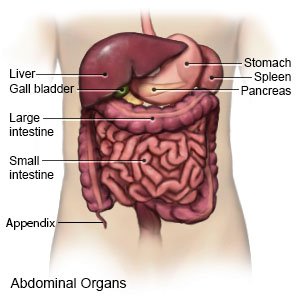Open Appendectomy
Medically reviewed by Drugs.com. Last updated on Aug 4, 2025.
An open appendectomy is surgery to remove your appendix through an incision in your lower abdomen.
 |
DISCHARGE INSTRUCTIONS:
Call 911 for any of the following:
- You have chest pain, more pain when you take a deep breath or cough, or you cough up blood.
- Your arm or leg feels warm, tender, and painful. It may look swollen and red.
- You feel lightheaded and have shortness of breath all of a sudden.
Seek care immediately if:
- Blood soaks through your bandage.
- Your incision is red, swollen, or has pus coming from it.
- Your stitches come apart.
- You have severe pain in your abdomen and it is swollen.
- You see a bulge coming out of your surgery site.
- You cannot stop vomiting.
Contact your healthcare provider if:
- You have a fever or chills.
- You have nausea or are vomiting.
- You have questions or concerns about your condition, surgery, or care.
Medicines:
You may need any of the following:
- Prescription pain medicine may be given. Ask your healthcare provider how to take this medicine safely. Some prescription pain medicines contain acetaminophen. Do not take other medicines that contain acetaminophen without talking to your healthcare provider. Too much acetaminophen may cause liver damage. Prescription pain medicine may cause constipation. Ask your healthcare provider how to prevent or treat constipation.
- Antibiotics help prevent or fight a bacterial infection.
- Take your medicine as directed. Contact your healthcare provider if you think your medicine is not helping or if you have side effects. Tell your provider if you are allergic to any medicine. Keep a list of the medicines, vitamins, and herbs you take. Include the amounts, and when and why you take them. Bring the list or the pill bottles to follow-up visits. Carry your medicine list with you in case of an emergency.
Related medications
Rest as needed:
You will need to go slowly and rest often. This will help protect the wound and prevent the stitches from coming out. Rest will help you heal. Do not lift anything heavier than 5 pounds. Ask your healthcare provider when it is okay to drive and do your other normal daily activities.
Care for your incision wound as directed:
Keep your wound clean and dry. You may need to cover your wound when you bathe so it does not get wet. When you are allowed to clean your wound, carefully wash it with soap and water, or as directed. Dry the area and put on new, clean bandages as directed. Change your bandages when they get wet or dirty. The strips of medical glue will fall off on their own. If they do not fall off within 10 days, you can gently peel them off. Check your wound for signs of infection, such as swelling, redness, or pus.
Care for your drain as directed:
You may go home with a drain coming out of your incision. A drain is a thin rubber tube used to remove extra fluid from your abdomen. Your healthcare provider will take the drain out when there is no more fluid coming from the incision. Ask your healthcare provider how to care for your drain. Do not remove your drain.
Apply ice on your incision wound:
Apply ice on your wound for 15 to 20 minutes every hour or as directed. Use an ice pack, or put crushed ice in a plastic bag. Cover it with a towel before you apply it to your skin. Ice helps prevent tissue damage and decreases swelling and pain.
Follow up with your healthcare provider as directed:
You may need to return to have your stitches or drain removed. Write down your questions so you remember to ask them during your visits.
© Copyright Merative 2025 Information is for End User's use only and may not be sold, redistributed or otherwise used for commercial purposes.
The above information is an educational aid only. It is not intended as medical advice for individual conditions or treatments. Talk to your doctor, nurse or pharmacist before following any medical regimen to see if it is safe and effective for you.
Further information
Always consult your healthcare provider to ensure the information displayed on this page applies to your personal circumstances.
